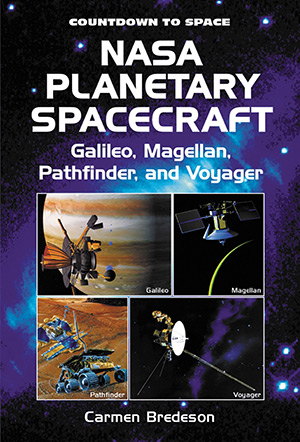Category: Children’s Book
Reviewed by: Veronica Ann Zabala-Aliberto
Title: NASA Planetary Spacecraft: Galileo, Magellan, Pathfinder, and Voyager (Countdown to Space series)
Author: Carmen Bredeson
Reading Level: Ages 9-12
NSS Amazon link for this book
Format: Hardcover
Pages: 48
Publisher: Enslow Publishers
Date: 2000
ISBN: 0766013030
Countdown to Space: NASA Planetary Spacecraft gives kids an up close and personal introduction to the planets and moons in our solar system via images returned by spacecraft. Author Carmen Bredeson writes about how Magellan revealed the temperature of Venus by remote sensing. She quotes a member of the Galileo imaging team saying that Europa, an icy moon of Jupiter, “is really the gem of the Solar System”. She explains how fractured ice over a salty ocean seen from the orbiter Galileo gives rise to the possibility of life on that moon. Firsthand accounts from scientists and engineers who worked on the Galileo, Magellan, Pathfinder and Voyager missions introduce young readers to what NASA has accomplished in planetary science and what it means to future exploration of the Solar System.
The reader gets a bird’s-eye view of spectacular planetary images of the planets’ and moons’ surfaces that were seen for the first time. Panoramic views from the Mars lander Pathfinder emphasize how similar Mars is to Earth and how possible it is for Mars to support a colony for people to live and work on the Red Planet.
This nonfiction children’s book is an excellent historical guide into planetary science which provides the roadmap we used BEFORE the Vision for Space Exploration was implemented on January 14, 2004 by President Bush to get us to the Moon, Mars and beyond. This book is a great educational outreach tool that provides enough evidence that we can accomplish great things as long as we believe and work together for a common goal. This is what the National Space Society strives for, and I highly recommend this book to educators and students.
A note to readers pertaining to websites depicted in this book. The internet addresses provided were active at the time of publication. This may not be the case today. For more information on the missions depicted in this book, please visit NASA’s website at www.nasa.gov or that of the Jet Propulsion Laboratory at www.jpl.nasa.gov for the latest information on past, current and future planetary missions.
© 2006 Veronica Ann Zabala-Aliberto
Please use the NSS Amazon Link for all your book and other purchases. It helps NSS and does not cost you a cent! Bookmark this link for ALL your Amazon shopping!



















